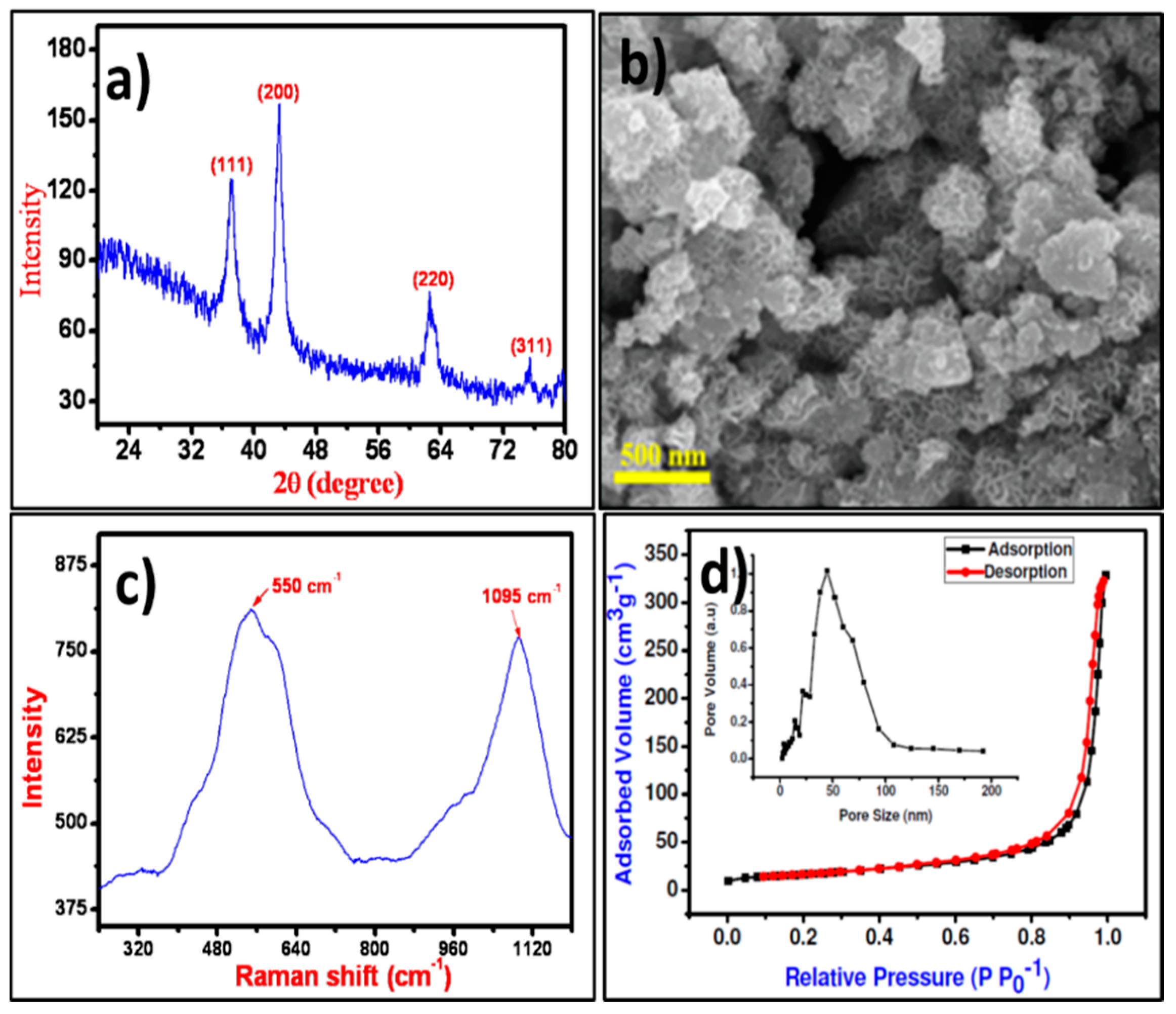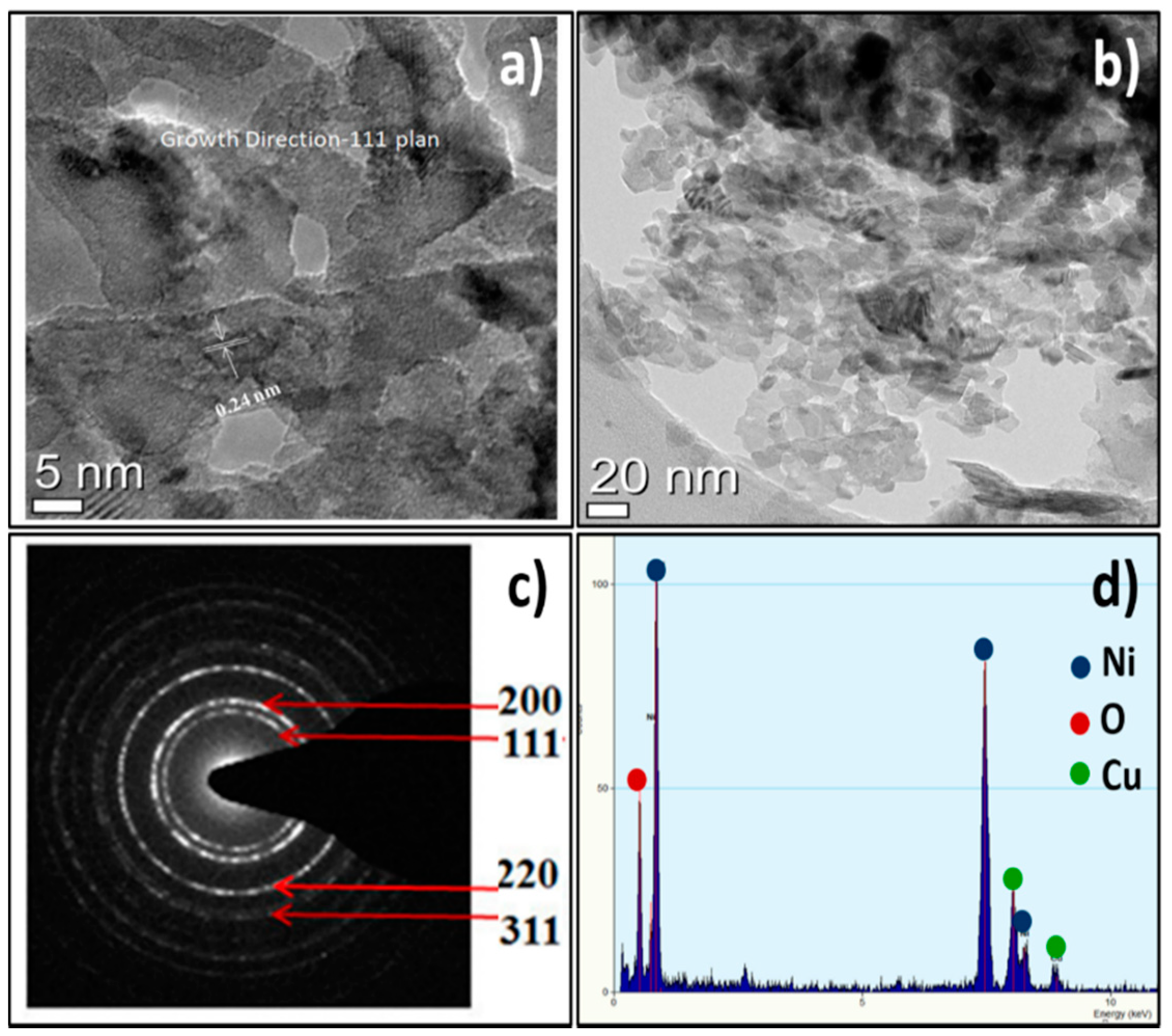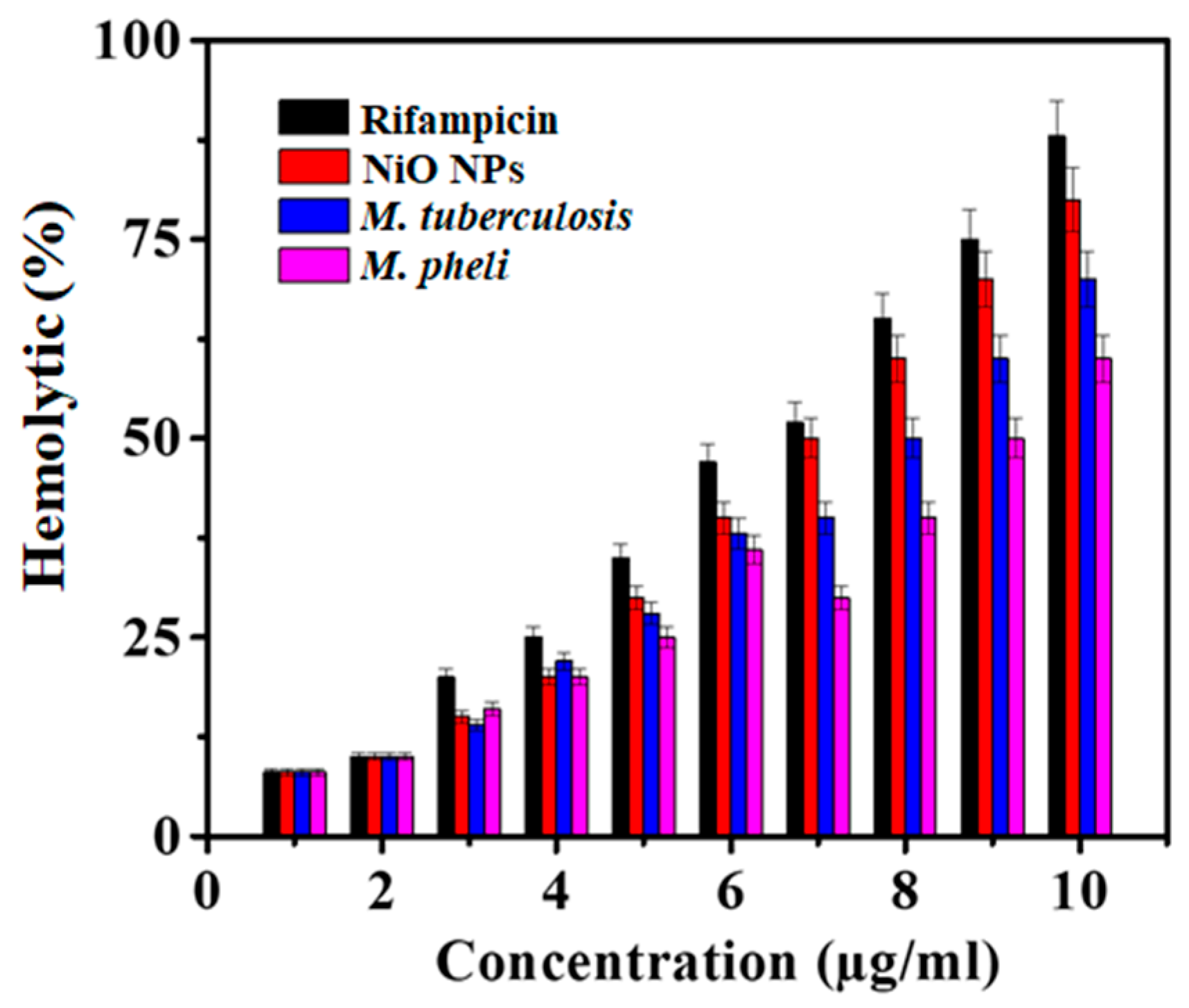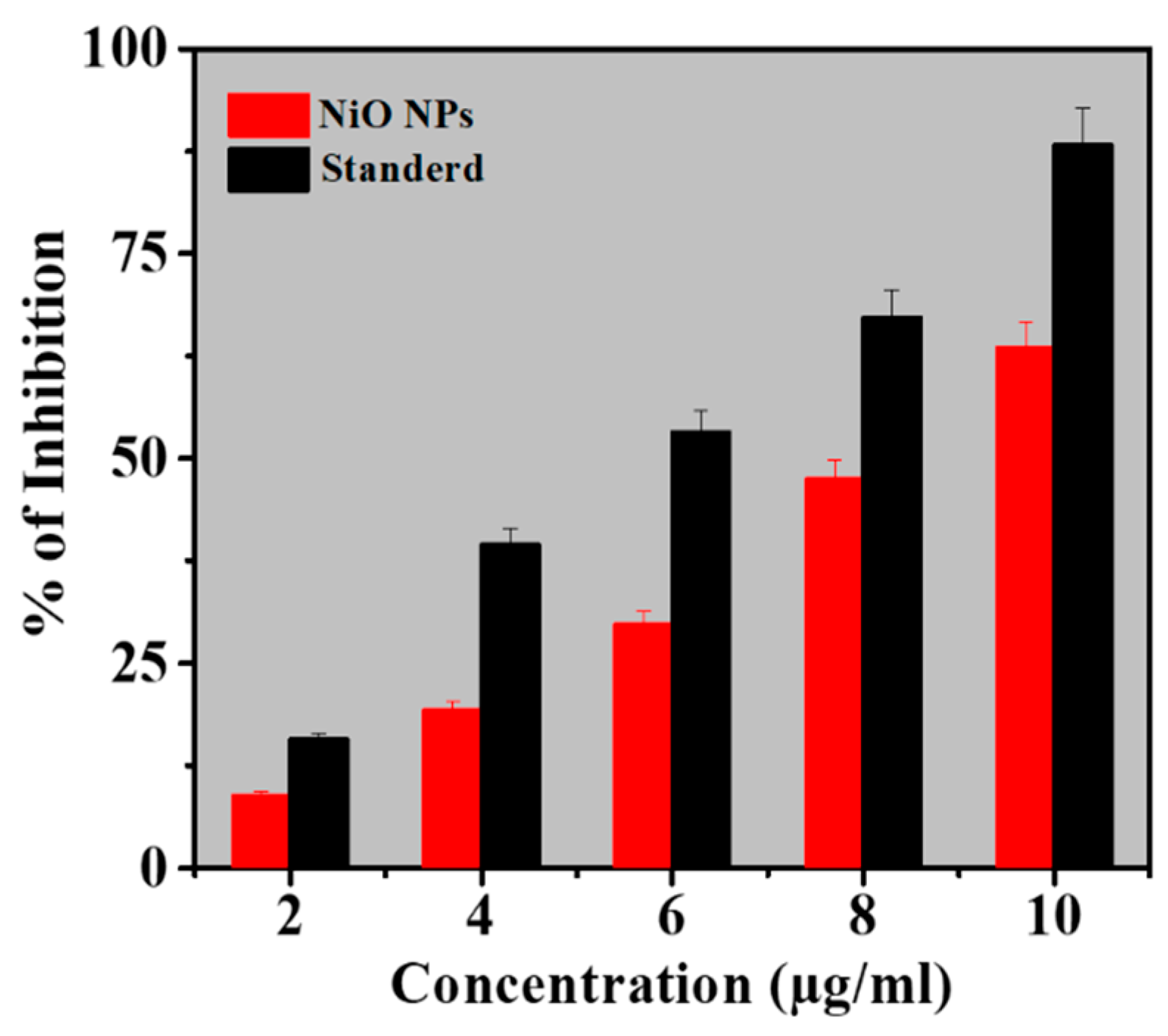Antimycobacterial, Antioxidant and Cytotoxicity Activities of Mesoporous Nickel Oxide Nanoparticles for Healthcare
Abstract
1. Introduction
2. Materials and Methods
2.1. Materials
2.2. Formulation of NiO NPs
2.3. Characterization Techniques
2.4. Antimycobacterial Activity
2.5. Hemolytic Assays
2.6. Antioxidant Activity
3. Results and Discussion
3.1. Structure, Morphology, and Porosity Measurements
3.2. Crystallite Size Analysis
3.3. Antimycobacterial Activity
3.4. Hemolysis Assay
3.5. Antioxidant Activity
4. Conclusions
Author Contributions
Funding
Acknowledgments
Conflicts of Interest
References
- Kumar, R.; Kumar, R. Nanoparticle-based drugs and formulations: Current status and emerging applications. ACS Appl. Nano Mater. 2020, 3, 4944. [Google Scholar] [CrossRef]
- Kannan, K.; Radhika, D.; Sadasivuni, K.K.; Reddy, K.R.; Raghu, A.V. Nanostructured metal oxides and its hybrids for photocatalyticand biomedical applications. Adv. Colloid Interface Sci. 2020, 281, 102178. [Google Scholar] [CrossRef] [PubMed]
- Mal, J.; Nancharaiahac, Y.V.; Hullebuschb, E.D.V.; Lensad, P.N.L. Metal chalcogenide quantum dots: Biotechnological synthesis and applications. RSC Adv. 2016, 6, 41477. [Google Scholar] [CrossRef]
- Shkir, M.; Yahia, I.S.; Ganesh, V.; Bitla, Y.; Ashraf, I.M.; Kaushik, A.; AlFaify, S. A facile synthesis of Au-nanoparticles decorated PbI2 single crystalline nanosheets for optoelectronic device applications. Sci. Rep. 2018, 8, 13806. [Google Scholar] [CrossRef] [PubMed]
- Sirelkhatim, A.; Mahmud, S.; Seeni, A.; Kaus, N.H.M.; Ann, L.C.; Bakhori, S.K.M.; Hasan, H.; Mohamad, D. Review on zinc oxide nanoparticles: Antibacterial activity and toxicity mechanism. Nano-Micro Lett. 2015, 7, 219–242. [Google Scholar] [CrossRef] [PubMed]
- Mokoena, T.P.; Swart, H.C.; Motaung, D.E. A review on recent progress of p-type nickel oxide based gas sensors: Future perspectives. J. Alloys Compd. 2019, 805, 267–294. [Google Scholar] [CrossRef]
- Patel, M.; Kim, H.-S.; Kim, J.; Yun, J.-H.; Kim, S.J.; Choi, E.H.; Park, H.-H. Excitonic metal oxide heterojunction (NiO/ZnO) solar cells for all-transparent module integration. Sol. Energy Mater. Sol. Cells 2017, 170, 246–253. [Google Scholar] [CrossRef]
- Li, Q.; Li, N.; An, J.; Pang, H. Controllable synthesis of a mesoporous NiO/Ni nanorod as an excellent catalyst for urea electro-oxidation. Inorg. Chem. Front. 2020, 7, 2089–2096. [Google Scholar] [CrossRef]
- Zhang, Y.; Wang, S.; Chen, L.; Fang, Y.; Shen, H.; Du, Z. Solution-processed quantum dot light-emitting diodes based on NiO nanocrystals hole injection layer. Org. Electron. 2017, 44, 189–197. [Google Scholar] [CrossRef]
- Al-Enizi, A.M.; Ubaidullaha, M.; Ahmed, J.; Ahamad, T.; Ahmad, T.; Shaikh, S.F.; Naushad, M. Synthesis of NiOx@NPC composite for high-performance supercapacitor via Waste PET plastic-derived Ni-MOF. Compos. Part B Eng. 2020, 183, 107655. [Google Scholar] [CrossRef]
- Chen, S.-C.; Kuo, T.-Y.; Lin, H.-C.; Chen, R.-Z.; Sun, H. Optoelectronic properties of p-type NiO films deposited by direct current magnetron sputtering versus high power impulse magnetron sputtering. Appl. Surf. Sci. 2020, 508, 145106. [Google Scholar] [CrossRef]
- Abualela, S.; Lv, X.; Hu, Y.; Abd-Alla, M.D. NiO nanosheets grown on carbon cloth as mesoporous cathode for High-performance lithium-sulfur battery. Mater. Lett. 2020, 268, 127622. [Google Scholar] [CrossRef]
- Di Girolamo, D.; Matteocci, F.; Piccinni, M.; Di Carlo, A.; Dini, D. Anodically electrodeposited NiO nanoflakes as hole selective contact in efficient air processed p-i-n perovskite solar cells. Sol. Energy Mater. Sol. Cells 2020, 205, 110288. [Google Scholar] [CrossRef]
- Abd El-Lateef, H.M.; Khalaf, M.M.; Al-Omair, M.A.; Dao, V.-D.; Mohamed, I.M.A. Chemical synthesis of NiO nanostructure by surfactant-assisted sol–gel methodology for urea electrocatalytic oxidation. Mater. Lett. 2020, 276, 128192. [Google Scholar] [CrossRef]
- Saikia, J.P.; Paul, S.; Konwar, B.K.; Samdarshi, S.K. Nickel oxide nanoparticles: A novel antioxidant. Colloids Surf. B Biointerfaces 2010, 78, 146–148. [Google Scholar] [CrossRef] [PubMed]
- Kale, S.S.; Mane, R.S.; Chung, H.; Yoon, M.-Y.; Lokhande, C.D.; Han, S.-H. Use of successive ionic layer adsorption and reaction (SILAR) method for amorphous titanium dioxide thin films growth. Appl. Surf. Sci. 2006, 253, 421–424. [Google Scholar] [CrossRef]
- Filion, M.C.; Lépicier, P.; Morales, A.; Phillips, N.C. Mycobacterium phlei cell wall complex directly induces apoptosis in human bladder cancer cells. Br. J. Cancer 1999, 79, 229–235. [Google Scholar] [CrossRef]
- Spiegl, P.V.; Feiner, C.M. Mycobacterium phlei infection of the foot: A Case Report. Foot Ankle Int. 1994, 15, 680–683. [Google Scholar] [CrossRef]
- Mohamed, K.; Zine, K.; Fahima, K.; Abdelfattah, E.; Sharifudin, S.M.; Duduku, K. NiO nanoparticles induce cytotoxicity mediated through ROS generation and impairing the antioxidant defense in the human lung epithelial cells (A549): Preventive effect of Pistacia lentiscus essential oil. Toxicol. Rep. 2018, 5, 480–488. [Google Scholar] [CrossRef]
- Mariam, A.; Kashif, M.; Arokiyaraj, S.; Bououdina, M.; Sankaracharyulu, M.; Jayachandran, M.; Hashim, U. Bio-synthesis of NiO and Ni nanoparticles and their characterization. Dig. J. Nanomater. Biostruct. 2014, 9, 1007–1019. [Google Scholar]
- Ada, K.; Turk, M.; Oguztuzun, S.; KILIÇ, M.; Demirel, M.; Tandogan, N.; Ersayar, E.; Öztürk, L. Cytotoxicity and apoptotic effects of nickel oxide nanoparticles in cultured HeLa cells. Folia Histochem. Cytobiol. 2010, 48, 524–529. [Google Scholar] [CrossRef] [PubMed]
- Ramasami, A.K.; Reddy, M.V.; Balakrishna, G.R. Combustion synthesis and characterization of NiO nanoparticles. Mater. Sci. Semicond. Process. 2015, 40, 194–202. [Google Scholar] [CrossRef]
- Talebian, N.; Doudi, M.; Kheiri, M. The anti-adherence and bactericidal activity of sol–gel derived nickel oxide nanostructure films: Solvent effect. J. Sol-Gel Sci. Technol. 2014, 69, 172–182. [Google Scholar] [CrossRef]
- Umaralikhan, L.; Jaffar, M. Antibacterial and anticancer properties of NiO nanoparticles by co-precipitation method. J. Adv. Appl. Sci. Res. 2016, 1, 24–35. [Google Scholar]
- Mutkule, S.U.; Navale, S.T.; Jadhav, V.V.; Ambade, S.B.; Naushad, M.; Sagar, A.D.; Patil, V.B.; Stadler, F.J.; Mane, R.S. Solution-processed nickel oxide films and their liquefied petroleum gas sensing activity. J. Alloys Compd. 2017, 695, 2008–2015. [Google Scholar] [CrossRef]
- Benzie, I.F.F.; Strain, J.J. Ferric reducing/antioxidant power assay: Direct measure of total antioxidant activity of biological fuids and modifed version for simultaneous measurement of total antioxidant power and ascorbic acid concentration. Methods Enzymol. 1999, 299, 15–27. [Google Scholar]
- Cort, W.M. Antioxidant properties of ascorbic acid in foods. In Ascorbic Acid: Chemistry, Metabolism, and Uses; Seib, P.A., Tolbert, B.M., Eds.; American Chemical Society: Washington, DC, USA, 2007; Volume 200, pp. 533–550. ISBN 9780841206328. [Google Scholar]
- Zhou, Q.; Lu, Z.; Wei, Z.; Xu, L.; Gui, Y.; Chen, W. Hydrothermal Synthesis of Hierarchical Ultrathin NiO Nanoflakes for High-Performance CH4 Sensing. Front. Chem. 2018, 6, 194. [Google Scholar] [CrossRef]
- El-Kemary, M.; Nagy, N.; El-Mehasseb, I. Nickel oxide nanoparticles: Synthesis and spectral studies of interactions with glucose. Mater. Sci. Semicond. Process. 2013, 16, 1747–1752. [Google Scholar] [CrossRef]
- Mironova-Ulmane, N.; Kuzmin, A.; Grabis, J.; Sildos, I.; Voronin, V.I.; Berger, I.F.; Kazantsev, V.A. Structural and magnetic properties of nickel oxide nanopowder. Solid State Phenom. 2011, 168, 341–344. [Google Scholar] [CrossRef]
- Harris, L.K.; Theriot, J.A. Surface Area to Volume Ratio: A natural variable for bacterial morphogenesis. Trends Microbiol. 2018, 26, 815–832. [Google Scholar] [CrossRef]
- Su, D.; Ford, M.; Wang, G. Mesoporous NiO crystals with dominantly exposed {110} reactive facets for ultrafast lithium storage. Sci. Rep. 2012, 2, 924. [Google Scholar] [CrossRef] [PubMed]
- Ubaidullah, M.; Ahmed, J.; Ahamad, T.; Shaikh, S.F.; Alshehri, S.M.; Al-Enizi, A.M. Hydrothermal synthesis of novel nickel oxide@nitrogenous mesoporous carbon nanocomposite using costless smoked cigarette filter for high performance supercapacitor. Mater. Lett. 2020, 266, 127492. [Google Scholar] [CrossRef]
- Ramalingam, V.; Sundaramahalingam, S.; Rajaram, R. Size-dependent antimycobacterial activity of titanium oxide nanoparticles against Mycobacterium tuberculosis. J. Mater. Chem. B 2019, 7, 4338–4346. [Google Scholar] [CrossRef]
- Hameed, A.S.H.; Karthikeyan, C.; Ahamed, A.P.; Thajuddin, N.; Alharbi, N.S.; Alharbi, S.A.; Ravi, G. In vitro antibacterial activity of ZnO and Nd doped ZnO nanoparticles against ESBL producing Escherichia coli and Klebsiella pneumoniae. Sci. Rep. 2016, 6, 24312. [Google Scholar] [CrossRef]
- da Silva, B.; Paiva Abuçafy, M.; Berbel Manaia, E.; Junior, J.; Chiari-Andréo, B.; Pietro, R.; Chiavacci, L. Relationship between structure and antimicrobial activity of zinc oxide nanoparticles: An overview. Int. J. Nanomed. 2019, 14, 9395–9410. [Google Scholar] [CrossRef] [PubMed]
- Dookie, N.; Rambaran, S.; Padayatchi, N.; Mahomed, S.; Naidoo, K. Evolution of drug resistance in Mycobacterium tuberculosis: A review on the molecular determinants of resistance and implications for personalized care. J. Antimicrob. Chemother. 2018, 73, 1138–1151. [Google Scholar] [CrossRef] [PubMed]
- Lippi, G.; Plebani, M.; Somma, S.; Cervellin, G. Hemolyzed specimens: A major challenge for emergency departments and clinical laboratories. Crit. Rev. Clin. Lab. Sci. 2011, 48, 143–153. [Google Scholar] [CrossRef]
- Kedare, S.B.; Singh, R.P. Genesis and development of DPPH method of antioxidant assay. J. Food Sci. Technol. 2011, 48, 412–422. [Google Scholar] [CrossRef] [PubMed]





| Sr. No. | Material | Minimum Inhibitory Concentration (µg/mL) | |
|---|---|---|---|
| M. tuberculosis | M. phlei | ||
| 1 | NiO NPs | 1.11 ± 0.10 * | 1.31 ± 0.06 * |
| 2 | Rifampicin | 0.9 ± 0.06 | 1.8 ± 0.06 |
| No | Comp. | Absorb. | Absorbance at 517 | ||||
|---|---|---|---|---|---|---|---|
| 2 (µg/mL) | 4 (µg/mL) | 6 (µg/mL) | 8 (µg/mL) | 10 (µg/mL) | |||
| 1 | Control | (Abs. Control) | 0.82 ± 0.04 | 0.82 ± 0.04 | 0.82 ± 0.04 | 0.82 ± 0.04 | 0.82 ± 0.04 |
| 2 | NiO NPs | (Abs Sample) % | 0.82 ± 0.03 | 0.63 ± 0.05 | 0.54 ± 0.04 | 0.43 ± 0.04 | 0.32 ± 0.04 |
| SA | 8.89 | 19.29 | 29.78 | 47.48 | 63.44 | ||
| 3 | Standard | (Abs Sample) % | 0.74 ± 0.03 | 0.64 ± 0.05 | 0.54 ± 0.04 | 0.43 ± 0.04 | 0.22 ± 0.04 |
| SA | 15.71 | 39.41 | 53.21 | 67.23 | 88.23 | ||
Publisher’s Note: MDPI stays neutral with regard to jurisdictional claims in published maps and institutional affiliations. |
© 2020 by the authors. Licensee MDPI, Basel, Switzerland. This article is an open access article distributed under the terms and conditions of the Creative Commons Attribution (CC BY) license (http://creativecommons.org/licenses/by/4.0/).
Share and Cite
Kote, J.R.; Kadam, A.S.; Ubaidullah, M.; Al-Enizi, A.M.; A. Al-Abdrabalnabi, M.; Nafady, A.; Imran, M.; Mane, R.S. Antimycobacterial, Antioxidant and Cytotoxicity Activities of Mesoporous Nickel Oxide Nanoparticles for Healthcare. Coatings 2020, 10, 1242. https://doi.org/10.3390/coatings10121242
Kote JR, Kadam AS, Ubaidullah M, Al-Enizi AM, A. Al-Abdrabalnabi M, Nafady A, Imran M, Mane RS. Antimycobacterial, Antioxidant and Cytotoxicity Activities of Mesoporous Nickel Oxide Nanoparticles for Healthcare. Coatings. 2020; 10(12):1242. https://doi.org/10.3390/coatings10121242
Chicago/Turabian StyleKote, Jivan R., Ambadas S. Kadam, Mohd Ubaidullah, Abdullah M. Al-Enizi, Mohammed A. Al-Abdrabalnabi, Ayman Nafady, Muhammad Imran, and Rajaram S. Mane. 2020. "Antimycobacterial, Antioxidant and Cytotoxicity Activities of Mesoporous Nickel Oxide Nanoparticles for Healthcare" Coatings 10, no. 12: 1242. https://doi.org/10.3390/coatings10121242
APA StyleKote, J. R., Kadam, A. S., Ubaidullah, M., Al-Enizi, A. M., A. Al-Abdrabalnabi, M., Nafady, A., Imran, M., & Mane, R. S. (2020). Antimycobacterial, Antioxidant and Cytotoxicity Activities of Mesoporous Nickel Oxide Nanoparticles for Healthcare. Coatings, 10(12), 1242. https://doi.org/10.3390/coatings10121242








